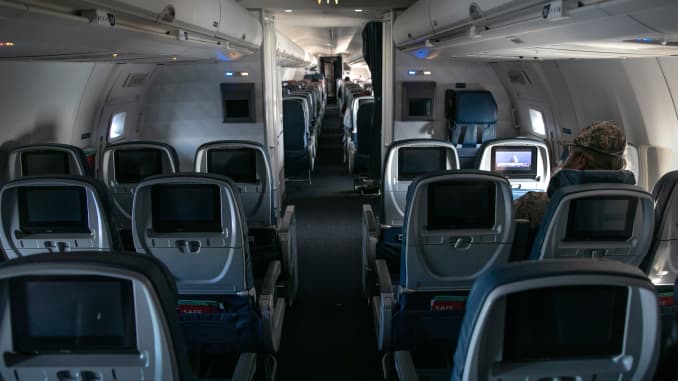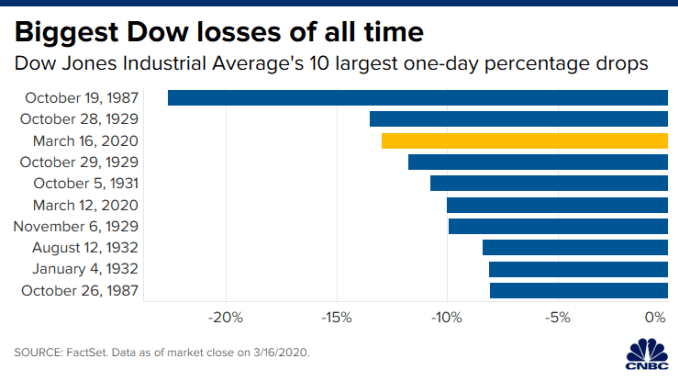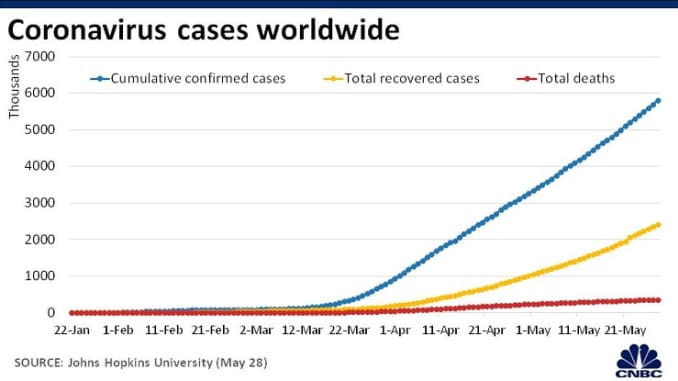'The situation is very serious': COVID-19 pandemic prompts Alberta to declare a state of public health emergency
Matthew Black CTV News Edmonton March 17, 2020
EDMONTON -- Alberta Premier Jason Kenney declared a public state of health emergency on Tuesday in an effort to combat the growing spread of COVID-19.
"The situation is very serious," said Kenney. "Decisive action is needed and we are taking that action."
"We have to take more aggressive measures to contain the virus, more aggressive social distancing measures."
Kenney also announced a number of new measures on social distancing as recommended by provincial health authorities, including a ban on any organized gatherings of more than 50 people.
Albertans are now prohibited from visiting a number of venues including: public recreation centres, casinos, bingo halls, bars, nightclubs, fitness centres, arenas, museums, and indoor children's play centres.
Sit-down restaurants, pubs, delis and coffee shops are now limited to a maximum of 50 people or 50 per cent of their maximum capacity, whichever is lower.
"Drive-thru, take-out and delivery will still be permitted," Kenney said adding the province has changed regulations allowing restaurants to engage in off-sales of liquor.
Conferences, weddings and funerals are not exempt from the declaration and should be cancelled, said Kenney.
He said the new restrictions go into effect immediately.
"I recognize these measures will have a profound impact on the lives of Albertans. But they are frankly necessary in the face of this growing pandemic."
Venues deemed to be essential services including grocery stores, airports, homeless shelters, soup kitchens and the Alberta legislature building will remain open.
The government also announced $60 million in funding to be sent to social agencies and another $30 million devoted to supporting seniors.
Kenney announced more government spending measures to deal with the economic implications of the pandemic will be announced tomorrow.
"This is a serious moment in our history," said Kenney. "This province is resilient and we are ready for the test."
Kenney said the availability of trained personnel remains a concern for health authorities as the pandemic continues.
He said the province may bring back recently retired medical professionals or cancel vacation for existing staff to boost the province's health care capacity.
WHAT DOES A PUBLIC HEALTH EMERGENCY MEAN?
The declaration comes under the province's Public Health Act which typically permits a 30-day period for the state of emergency, which can be extended to 90 days.
Kenney said the declaration is limited to health care powers, where section 52 of the act allows a 60-day state of emergency to "prompt co-ordination of action or special regulation of persons or property is required in order to protect the public health."
The Emergency Management Act also allows the government to take central control of a crisis by enacting a number of emergency powers over a 28-day period, including:
Putting into operation an emergency plan or program.
Authorize or require local authorities to put into effect their own emergency plans.
Acquire or use any property necessary to prevent or alleviate the effects of the emergency.
Control or prohibit travel to or from any area of Alberta.
Procure or fix prices for food, clothing, fuel, equipment, or other essential supplies.
Order the evacuation of persons and property from any area affected by a disaster.
Kenney said his government is not enacting all aspects of the act's powers, instead using the declaration to aid health care administration. He said the other powers could be used in the future if needed.
The legislation permits for a 90-day period if the order is "in respect of a pandemic influenza."
In 2016, the province declared a provincial state of emergency in response to the Fort McMurray fires. The state of emergency came into effect on May 4, 2016 and lasted for 58 days, until July 1, 2016.
Earlier Tuesday, Ontario Premier Doug Ford declared a state of emergency in his province, including a ban on public events of over 50 people including parades, events and services within places of worship until March 31.
'This is a serious moment in our history': Alberta Premier Jason Kenney declares public health emergency
Bars, casinos to shut immediately while restaurants, coffee shops to get seating limits
CBC News · Posted: Mar 17, 2020
The decision to put the province under a state of public emergency is part of Alberta's effort in a bid to slow the rising number of coronavirus infections. 3:02Alberta Premier Jason Kenney has declared a state of public health emergency as the province works to contain the COVID-19 pandemic.
"This declaration is meant to empower authorities under the Public Health Act to effectively manage the COVID response," Kenney said.
"Decisive action is needed and we are taking that action."
Kenney made the announcement Tuesday at the Alberta legislature.
Alberta's Provincial Operations Centre has been elevated from a level 3 to a level 4, the highest level, Kenney said.
he funding will go to adult homeless shelters, women's emergency shelters and the Family and Community Support Services (FCSS) program, which supports municipalities and civil society organizations in providing services to vulnerable Albertans.
Bars, nightclubs and casinos will close immediately.
Seating in restaurants and coffee shops will be limited to a maximum of 50 people or 50-per-cent capacity, whichever is lower, he said.
Take-out, delivery and drive-through service is permitted.
Licensed facilities will also be permitted to deliver liquor, in part to help them sell off inventory.
"We apologize to operators of these establishments for the suddenness of this, although I think they've seen it coming," Kenney said.
Mass gatherings are now limited to no more than 50 attendees. This includes worship gatherings and family events such as weddings, the province said in a news release.
Kenney said funerals with more than 50 people should also be cancelled.
Grocery stores, shopping centres, health-care facilities, airports, the legislature and other essential services are not included. Soup kitchens and homeless shelters will also not be affected by the order.
Albertans are prohibited from attending public recreational facilities and private entertainment facilities, including gyms, swimming pools, arenas, science centres, museums, art galleries, community centres, children's play centres, casinos, racing entertainment centres, and bingo halls.
Not-for-profit community kitchens, soup kitchens and religious kitchens are exempt, but sanitization practices are expected to be in place and support will be in place for this practice
The decision to put the province under a state of public health emergency is part of Alberta's effort to try to slow the rising number of coronavirus infections.
"This is a serious moment in our history and COVID-19 will test us," Kenney said. "We will do whatever it takes to slow the spread of this virus."
$60 million in emergency funding
Municipalities, charitable and non-profit organizations providing social services support will immediately get $60 million to help their COVID-19 response, the government news release said.
The money will be dispersed before March 31, Kenney said. He said he has appointed Jeremy Nixon, former executive director of The Mustard Seed, as parliamentary secretary for civil society.
Nixon will work with charities and non-profits to ensure they are helping to reach out to seniors and other vulnerable people who are in isolation.
Half of the $60 million will be dedicated to immediate support to women's shelters and homeless shelters.
The other $30 million will extend support services to seniors and other communities who are isolated because of the pandemic or otherwise affected.
Don't hoard groceries, Kenney says
Kenney said he has been assured by the Retail Council of Canada, and chains such as Loblaws and Walmart, that supply chains and food security are not compromised, so there is no need for people to engage in hoarding or panic buying.
"We do recommend that people have enough food on hand to cope through a couple of weeks, given the likelihood that many people will be affected by self-isolation for 14 days," he said. "But there is no logical reason for people to go out and buy weeks and weeks or months of supplies."
He commended Alberta retailers who have set specific hours for seniors to do their shopping in safety, and encouraged all other retailers to follow suit.
Emergency Management Act may be needed
Kenney said officials may decide to invoke other powers under the Emergency Management Act.
Those powers could be used to prevent people from leaving or entering the province, or allow authorities to seize property, he said
"It's conceivable that if the pandemic goes in the wrong direction, that we may need to effectively use hotels to house people for quarantine, for example," Kenney said.
"The [legislation] would give us those authorities. We do not believe that they are currently necessary but I have told officials that if they believe we need those powers, they should recommend it and we should invoke that."
Earlier Tuesday, Ontario Premier Doug Ford declared a state of emergency in that province

Public health emergency declared in Alberta
 NOW PLAYING
Alberta Premier Jason Kenney declares a state of emergency amid COVID-19 pandemic.
What does public health emergency mean for you?COVID-19 Cases in Alberta
NOW PLAYING
Alberta Premier Jason Kenney declares a state of emergency amid COVID-19 pandemic.
What does public health emergency mean for you?COVID-19 Cases in Alberta
 NOW PLAYING
Alberta Premier Jason Kenney lists the aggressive new measures to control the spread of COVID-19. Full coverage at CTVNews.ca/Coronavirus
NOW PLAYING
Alberta Premier Jason Kenney lists the aggressive new measures to control the spread of COVID-19. Full coverage at CTVNews.ca/Coronavirus
Tracking every case of COVID-19 in Canada
BREAKING
Alberta declares state of public health emergency over COVID-19
BREAKING
PM Trudeau says emergency measures are under consideration
LIVE @ 3:30 P.M.
Alberta provides COVID-19 update
WATCH LIVE
CTV News Channel ongoing coverage and updates on the COVID-19 outbreak



















